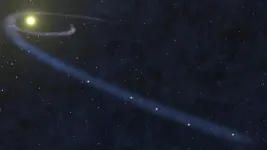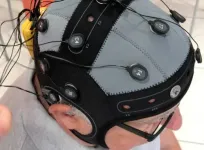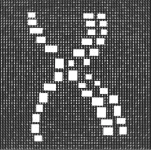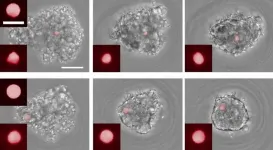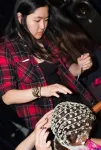(Press-News.org) Astronomers have for the first time used distant galaxies as 'scintillating pins' to locate and identify a piece of the Milky Way's missing matter.
For decades, scientists have been puzzled as to why they couldn't account for all the matter in the universe as predicted by theory. While most of the universe's mass is thought to be mysterious dark matter and dark energy, 5 percent is 'normal matter' that makes up stars, planets, asteroids, peanut butter and butterflies. This is known as baryonic matter.
However, direct measurement has only accounted for about half the expected baryonic matter.
Yuanming Wang, a doctoral candidate in the School of Physics at the University of Sydney, has developed an ingenious method to help track down the missing matter. She has applied her technique to pinpoint a hitherto undetected stream of cold gas in the Milky Way about 10 light years from Earth. The cloud is about a trillion kilometres long and 10 billion kilometres wide but only weighing about the mass of our Moon.
The results, published in the Monthly Notices of the Royal Astronomical Society, offer a promising way for scientists to track down the Milky Way's missing matter.
"We suspect that much of the 'missing' baryonic matter is in the form of cold gas clouds either in galaxies or between galaxies," said Ms Wang, who is pursuing her PhD at the Sydney Institute for Astronomy.
"This gas is undetectable using conventional methods, as it emits no visible light of its own and is just too cold for detection via radio astronomy," she said.
What the astronomers did is look for radio sources in the distant background to see how they 'shimmered'.
"We found five twinkling radio sources on a giant line in the sky. Our analysis shows their light must have passed through the same cold clump of gas," Ms Wang said.
Just as visible light is distorted as it passes through our atmosphere to give stars their twinkle, when radio waves pass through matter, it also affects their brightness. It was this 'scintillation' that Ms Wang and her colleagues detected.
Dr Artem Tuntsov, a co-author from Manly Astrophysics, said: "We aren't quite sure what the strange cloud is, but one possibility is that it could be a hydrogen 'snow cloud' disrupted by a nearby star to form a long, thin clump of gas."
Hydrogen freezes at about minus 260 degrees and theorists have proposed that some of the universe's missing baryonic matter could be locked up in these hydrogen 'snow clouds'. They are almost impossible to detect directly.
"However, we have now developed a method to identify such clumps of 'invisible' cold gas using background galaxies as pins," Ms Wang said.
Ms Wang's supervisor, Professor Tara Murphy, said: "This is a brilliant result for a young astronomer. We hope the methods trailblazed by Yuanming will allow us to detect more missing matter."
The data to find the gas cloud was taken using the CSIRO's Australian Square Kilometre Array Pathfinder (ASKAP) radio telescope in Western Australia.
Dr Keith Bannister, Principal Research Engineer at CSIRO, said: "It is ASKAP's wide field of view, seeing tens of thousands of galaxies in a single observation that allowed us to measure the shape of the gas cloud."
Professor Murphy said: "This is the first time that multiple 'scintillators' have been detected behind the same cloud of cold gas. In the next few years, we should be able to use similar methods with ASKAP to detect a large number of such gas structures in our galaxy."
Ms Wang's discovery adds to a growing suite of tools for astronomers in their hunt for the universe's missing baryonic matter. This includes a method published last year by the late Jean-Pierre Macquart from Curtin University who used CSIRO's ASKAP telescope to estimate a portion of matter in the intergalactic medium using fast radio bursts as 'cosmic weigh stations'.
INFORMATION:
Ms Wang and Professor Murphy's research was done in collaboration with CSIRO, Manly Astrophysics, the University of Wisconsin-Milwaukee and the ARC Centre of Excellence for Gravitational Wave Discovery, OzGrav.
DOWNLOAD the illustration, photos and a copy of the research at this link.
INTERVIEWS
Ms Yuanming Wang | ywan3191@uni.sydney.edu.au (English and Chinese)
Professor Tara Murphy | tara.murphy@sydney.edu.au (English)
MEDIA ENQUIRIES
Marcus Strom | marcus.strom@sydney.edu.au | +61 423 982 485
DECLARATION
The Australian Square Kilometre Array Pathfinder is part of the Australia Telescope National Facility which is managed by CSIRO, Australia's national science agency. ASKAP uses the resources of the Pawsey Supercomputing Centre. Establishment of ASKAP, the Murchison Radio-astronomy Observatory and the Pawsey Supercomputing Centre are initiatives of the Australian Government, with support from the Government of Western Australia and the Science and Industry Endowment Fund.
Yuanming Wang is supported by the China Scholarship Council. Tara Murphy acknowledges the support of the Australian Research Council. David Kaplan is supported by a US National Science Foundation grant. This work used resources of China SKA Regional Centre prototype funded by the National Key R&D Programme of China and the Chinese Academy of Sciences.
The researchers acknowledge the Wajarri Yamatji as the traditional owners of the Murchison Radio-astronomy Observatory site.
Using AI and computer automation, Technion researchers have developed a "conjecture generator" that creates mathematical conjectures, which are considered to be the starting point for developing mathematical theorems. They have already used it to generate a number of previously unknown formulas. The study, which was published in the journal Nature, was carried out by undergraduates from different faculties under the tutelage of Assistant Professor Ido Kaminer of the Andrew and Erna Viterbi Faculty of Electrical Engineering at the Technion.
The project deals with one of the most fundamental elements of mathematics - mathematical constants. ...
When treating cancer, researchers are always searching for ways to remove cancer cells while minimizing damage to the rest of the body. One possible approach is to find processes unique to cancer cells, and which would allow specific targeting. If such a process can be disrupted, only those cells would be affected.
A process (or absence thereof) can be unique to some types of cancer, and not be present in others. In such a case, we would want a simple way to recognize whether a particular tumor possesses the unique trait or not. The implication of this question is whether the tumor would respond to ...
Researchers from the HSE Institute for Cognitive Neuroscience have proposed a new method to process magnetoencephalography (MEG) data, which helps find cortical activation areas with higher precision. The method can be used in both basic research and clinical practice to diagnose a wide range of neurological disorders and to prepare patients for brain surgery. The paper describing the algorithm was published in the journal NeuroImage.
Magnetoencephalography (MEG) is a method based on measuring very weak magnetic fields (several orders of magnitude weaker than the Earth's magnetic field) induced by the brain's electrical activity. When using MEG, researchers face the complicated task ...
Professionalisation in any field requires long-term experience and training. In the past decades, studies have demonstrated that the professionalisation of athletes and artists create differences in the behaviour of the brain while carrying out activities related to their area of expertise.
To detect the effects of media professionalisation in the brain, a research team from the Universitat Autònoma de Barcelona, the Instituto Ràdio Televisió Espanyola and the Universidad Pablo de Olavide in Seville conducted a study published in Frontiers in Systems Neuroscience in which audiovisual contents were presented to a group of media ...
Machines, thanks to novel algorithms and advances in computer technology, can now learn complex models and even generate high-quality synthetic data such as photo-realistic images or even resumes of imaginary humans. A study recently published in the international journal PLOS Genetics uses machine learning to mine existing biobanks and generate chunks of human genomes which do not belong to real humans but have the characteristics of real genomes.
"Existing genomic databases are an invaluable resource for biomedical research, but they are either not publicly accessible or shielded behind long and exhausting application procedures due to valid ethical concerns. This creates a major scientific barrier for researchers. Machine-generated genomes, or artificial ...
PROVIDENCE, R.I. [Brown University] -- A new technique developed by Brown University researchers reveals the forces involved at the cellular level during biological tissue formation and growth processes. The technique could be useful in better understanding how these processes work, and in studying how they may respond to environmental toxins or drug therapies.
As described in the journal Biomaterials, the technique makes use of cell-sized spheres made from a highly compliant polymer material, which can be placed in laboratory cultures of tissue-forming cells. As the tissue-formation process unfolds, microscope imaging of the spheres, which are stained with fluorescent dye, reveals the extent to which they are deformed by the pressure of surrounding cells. A ...
Bird species that live in their natural habitats can help zoos learn how to manage those in captivity, according to a new review.
Birds are the most diverse group housed by zoos around the world, but zoo-based research tends not to focus on birds.
A new article published in the journal Birds, by Dr Paul Rose of the University of Exeter, suggests zoos can improve management of birds by looking at how species live in their natural habitats.
Likewise, birds living under the care of humans can also help guide and develop conservation action for those living in the wild.
"Research into wild birds is extremely useful for furthering how birds are managed in zoos," said ...
Scientists have made a significant breakthrough in the quest to understand the intricate processes that occur in the brain during seizures that are the key symptom of epilepsy.
A team of scientists from the University of Exeter has studied the mechanisms behind distinctive patterns of electrical activity of neuron groups in the brain that accompany the onset of seizures.
In healthy brains, networks of neurons move through states of similar behavior - known as synchronization - and dissimilar behavior, called desynchronization. These processes are also associated with both memory and attention.
However, in a brain with a neurological disorder, such as epilepsy, ...
Neuroscientists at McMaster University have found a link between children who are at risk for developmental coordination disorder (DCD), a common condition that can cause clumsiness, and difficulties with time perception such as interpreting changes in rhythmic beats.
Accurate time perception is crucial for basic skills such as walking and processing speech and music.
"Many developmental disorders, including dyslexia or reading difficulties, autism and attention deficits have been linked to deficits in auditory time perception," says Laurel Trainor, senior author of the study and founding director of the McMaster Institute for Music and the Mind.
Previous research has shown the brain ...
(Boston)--A new study recommends healthy children with symptoms of sleep disordered breathing, such as snoring or temporary cessation of breathing, should consider undergoing a sleep study (polysomnography) and should discuss the potential benefits of this with their pediatrician or otolaryngologist to possibly manage the child's symptoms medically and before surgery.
Sleep disordered breathing is common in children and ranges from mild snoring to severe sleep apnea. Doing a sleep study provides more information on the severity of the condition. Often doctors suggest adenotonsillectomy ...
